R.J. Stowell's Blog: rjsomeone, page 51
December 23, 2018
Brian Jones
 In his chronicle of the times, "Fallen Knights and Fallen Ladies" (from the book Nobody Waved Goodbye), Lou Reed said,
In his chronicle of the times, "Fallen Knights and Fallen Ladies" (from the book Nobody Waved Goodbye), Lou Reed said, After the Beatles came the Stones and of the Stones one could never have ignored Brian Jones with his puffed up Pisces, all-knowing, all suffering fish eyes, his incredible clothes, those magnificent scarves, Brian always ahead of style, perfect Brian. How could Brian have asthma, a psychological disease (we're told) and certainly something strange for a member of a rock and roll group. We read in interviews that Brian saw himself as the original lead Stone, a position he held until their American tour singled out Mick for the honor in the hearts of the American female. Can you remember 1964 when the Stones were called homosexual for long hair? (Were you?) Brian with two fourteen year old girls draped on each arm, must have laughed. And yet, the center of attention was drifting. In a group the attention may be evenly distributed (we all knew and loved John, Paul, George and Ringo) but in the Stones it was to be Mick. Now normally in a group an instrumentalist can never overshadow a lead singer (Exception: The Yardbirds where Eric Clapton, Jeff Beck and Jimmy Page did just that to poor Keith Relf). In the Stones there was Mick, the pivotal center. Charlie and Bill were for gourmets. That left Keith and Brian. Lead guitar always beats rhythm guitar for popularity, so that left Brian, who one assumes therefore turned to more and more exotic instruments to establish his presence to both himself and others. This is what I'm worth. Let me see you play the damn thing....but the great mass looked to Mick not Brian to be their leader through this Fall From Grace. And how can you take that? "But I started the thing," you might say. "It was my records in the first place, I turned them on, must I be a damn singer to turn on the world?" Yes, Or the champion of the guitar.
Then, of course, there are more problems, the drug arrests, the constant mental turmoil. What if they tour without me? Financial. Could I starve? (He died well in debt). If they play without me I shall be disgraced and have nothing where as if I leave and strike out on my own I'm out before they get me (how sad! how inevitable!), and I create my own myth, style, voice, the eyes will be on me, I have a future, there's so much I know, music, music, music, who would know it from THAT, I can do it, I have to do it, I will do it. And of course the disorientation, am I backwards, forwards, the asthma attack (I am going to choke), the fall (where is the pool?!) and everything settles like a quiet bubble coming in spurts and then thin streams until finally the last one has popped itself right out of earthly existence.

It was in June 1969 that Jones quit the band he'd founded and named The Rolling Stones. Jones played a pivotal role in the Stones' success, with his blond hair, Bohemian dress and good looks, as well as his ability to play any instrument within minutes of picking it up. Jones, though un-credited, co-wrote and played the recorders and cello on "Ruby Tuesday," sitar and tamboura on "Paint It, Black," dulcimer on "I Am Waiting" and "Lady Jane," the lead guitar riff on "Get Off My Cloud," harpsichord on "Yesterday's Papers," the trumpet and trombone on "Something Happened To Me Yesterday," the marimba on "Under My Thumb," and the autoharp on "You Got The Silver." All, today, unnoticed.

He began losing control of the group when Jagger and Richards began their songwriting partnership in 1965, which slowly moved the band away from Jones' blues-based direction. By 1966, Jones' mental instability and drug abuse had become a liability to the Stones. Due to his substance abuse problems, Jones frequently missed tour dates and recording sessions, and was unable to function within the band when he did attend.
While there is controversy over whether Jones quit the band or was "fired" (based supposedly on Jones' inability to obtain U.S. working papers for the upcoming North American tour). While Jones claimed that he quit the band, a settlement was reached that he'd receive $200,000 as severance and $40,000 per year for as long as the Stones remained a band. (With Mick Jagger's net worth at $305 mil., it doesn't seem like much in the way of severance.)
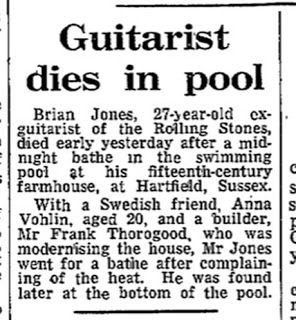 A month later, July 3, 1969, Jones was dead, found at the bottom of the swimming pool at his Cotchford Farm home. "Death by Misadventure" was the analysis of the coroner's office. A memorial service was held on the 10th at Cheltenham parish church, attended by Rolling Stones Charlie Watts and Bill Wyman (Mick Jagger was in Australia, where girlfriend Marianne Faithfull had been hospitalized following a suicide attempt). But the most lasting memorial was held two days after Jones' death, when his former bandmates paid tribute at the free concert in Hyde Park. Jagger, asking the audience to "cool it for a minute," read a poem by Percy Shelley before thousands of butterflies were released above the crowds. A fitting homage to a rock icon, and YET – were I a conspirist, I'd go into the whole murder thing, but I'm not; I'll leave that to the pale guy on ABC ("Could it be…murder?").
A month later, July 3, 1969, Jones was dead, found at the bottom of the swimming pool at his Cotchford Farm home. "Death by Misadventure" was the analysis of the coroner's office. A memorial service was held on the 10th at Cheltenham parish church, attended by Rolling Stones Charlie Watts and Bill Wyman (Mick Jagger was in Australia, where girlfriend Marianne Faithfull had been hospitalized following a suicide attempt). But the most lasting memorial was held two days after Jones' death, when his former bandmates paid tribute at the free concert in Hyde Park. Jagger, asking the audience to "cool it for a minute," read a poem by Percy Shelley before thousands of butterflies were released above the crowds. A fitting homage to a rock icon, and YET – were I a conspirist, I'd go into the whole murder thing, but I'm not; I'll leave that to the pale guy on ABC ("Could it be…murder?"). 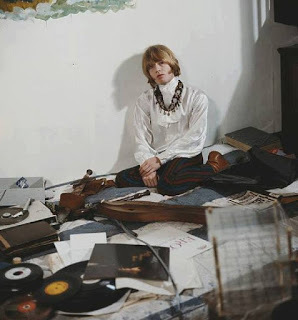 Better to leave off with the homage of Marianne Faithfull: "One of the best things about visiting Anita [Jone's gf] and Brian was watching them get ready to go out. What a scene! They were both dauntless shoppers and excessively vain. Hours and hours were spent putting on clothes and taking them off again. Heaps of scarves, hats, shirts and boots flew out of drawers and trunks. Unending trying on of outfits, primping and sashaying. They were beautiful, they were the spitting image of each other and not an ounce of modesty existed between two of them. I would sit mesmerized for hours, watching them preening in the mirror, trying on each other's clothes. All roles and gender would evaporate in these narcissistic performances, where Anita would turn Brian into the Sun King, Francoise Hardy or the mirror image of herself."
Better to leave off with the homage of Marianne Faithfull: "One of the best things about visiting Anita [Jone's gf] and Brian was watching them get ready to go out. What a scene! They were both dauntless shoppers and excessively vain. Hours and hours were spent putting on clothes and taking them off again. Heaps of scarves, hats, shirts and boots flew out of drawers and trunks. Unending trying on of outfits, primping and sashaying. They were beautiful, they were the spitting image of each other and not an ounce of modesty existed between two of them. I would sit mesmerized for hours, watching them preening in the mirror, trying on each other's clothes. All roles and gender would evaporate in these narcissistic performances, where Anita would turn Brian into the Sun King, Francoise Hardy or the mirror image of herself." On a personal note, I made a pilgrimage to Brian's grave in the mid '80s. Even then, the locals were still talking about him, and were eager to tell me stories in the pub about his funeral. At his grave was a crazy chick who was crying, all the way from Denmark.
Published on December 23, 2018 06:27
December 22, 2018
AM on the Radio
 AM has been going strong now for more than four years. Thanks to our loyal readers, we've been able to present modern music in a positive format that allows us to wallow in the history of rock music from the mid-60s to today. We're taking another step now by bringing AM to the radio. Check us out at
Daybreak USA
where twice per week you can catch our five-minute broadcast as a part of Daybreak with Rodd and Rae. The new radio segment will highlight the 50th anniversaries of the music we love. 50 years ago we wore fringed leather jackets or go-go boots made for walkin' and it was the time and the season for loving. Stereotypes aside (not that we don't relish in our stereotypes), join us each week to relive 1968 and AM on the Radio.
AM has been going strong now for more than four years. Thanks to our loyal readers, we've been able to present modern music in a positive format that allows us to wallow in the history of rock music from the mid-60s to today. We're taking another step now by bringing AM to the radio. Check us out at
Daybreak USA
where twice per week you can catch our five-minute broadcast as a part of Daybreak with Rodd and Rae. The new radio segment will highlight the 50th anniversaries of the music we love. 50 years ago we wore fringed leather jackets or go-go boots made for walkin' and it was the time and the season for loving. Stereotypes aside (not that we don't relish in our stereotypes), join us each week to relive 1968 and AM on the Radio.
Published on December 22, 2018 06:16
50 Years On - Beggar's Banquet
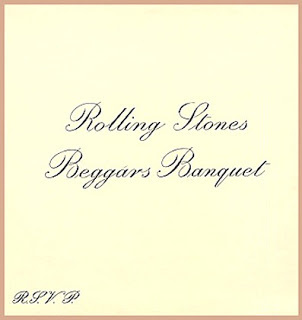 "We were starting to find the Rolling Stones," Keith Richards said during the Beggar's Banquet sessions — it's a pretty bold statement from the man who created the single most iconic guitar riff in rock music with "Satisfaction" in 1965. And yet, if one takes the remark to mean "We were carving in stone the dictionary definition of the Rolling Stones," then it's fairly accurate. Despite the myriad of hits from the mid-sixties incarnation of the band, the Stones had always been in The Beatles' shadow.
"We were starting to find the Rolling Stones," Keith Richards said during the Beggar's Banquet sessions — it's a pretty bold statement from the man who created the single most iconic guitar riff in rock music with "Satisfaction" in 1965. And yet, if one takes the remark to mean "We were carving in stone the dictionary definition of the Rolling Stones," then it's fairly accurate. Despite the myriad of hits from the mid-sixties incarnation of the band, the Stones had always been in The Beatles' shadow. Several factors converged together by early 1968 to ensure that transformation. First, music was evolving, and the Stones — Mick Jagger in particular — were anxious about missing those precious relevant trends that would ensure their remaining on top. "Englishness," à la Ray Davies, was not one of those trends: the Kinks were beginning to lose their commercial appeal (and of course were particularly unknown in the U.S.), and Mod culture in the U.K. was dissipating. The flower power thing, having peaked in The Summer of Love, suffered the same fate. On the other hand, the roots revival, exemplified by Dylan and the Byrds, seemed to be gaining the upper hand. And once Hendrix and the Who opened the floodgates for experimental electric guitar, successful hard rock acts began pouring in. It didn't take long for the Stones to learn which way the wind was blowing.
By 1968, Brian Jones was no longer a vital presence in the band: drugs coupled with psychological issues reduced him to a ghost of his psychedelic self, even as Keith, whose own drug problem was hardly any better, found the discipline to hold the rudder. Although there's little doubt that Mick and Keith cheated Brian out of songwriting credits, he was still an integral part of the band's sound with all the exotic instrumentation and psychedelic flavor. "No Expectations" would have been bland without Brian's slide; "Parachute Woman" would be less haunting without his harmonica; "Street Fighting Man" less tense and ominous without his sitar. These elements offer vital links with the Stones' recent past, turning Beggars Banquet into something larger than just a "roots-rock" album and adding enough mystery and psychologism to suggest that even at this point, it may not yet have been too late for Brian to clean up his messy act and reassert his place in the band. Beggar's Banquet is the one album, out of the big four of 1968-72 to appeal the most to all those who typically prefer the pop era of the Stones. Novice Stones fans would be wise to start with Flowers, the Stones' pop compilation, and Beggar's Banquet.
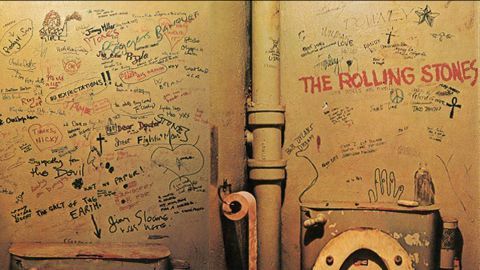
Published on December 22, 2018 05:22
December 20, 2018
Re-Post: When Rock 'n' Roll Became Rock
 Music evolves, goes from 8 track to 16 to digital, takes on a new parlance, someone messes with a Coke can or a hurdy-gurdy, with tape loops and feedback, but 50 years ago, pop music changed its meaning. In July '65, unabashed back-alley hooligans, The Rolling Stones, hit No. 1 with "Satisfaction," a song in which witty complaints about sexual frustration and social hypocrisy sowed the seeds of genuine protest. The next month, Dylan's "Like a Rolling Stone" shot to No. 2, fired by poetic language that spoke of the freedom, and the fear, of leaving social conventions behind. By October it was full tilt with Barry McGuire's "Eve of Destruction," and in December The Who (more riff-raff) released "My Generation," a stammering, in your face, take no shit anthem that drew a violent line in the sand between young and old. The Generation Gap had arrived. To mark so huge a sea change, the sound got a new title — or at least an amended one: the music previously known as "rock 'n' roll" morphed into the emphatic, yet simply named "rock." Like when dungarees became jeans and stayed that way.
Music evolves, goes from 8 track to 16 to digital, takes on a new parlance, someone messes with a Coke can or a hurdy-gurdy, with tape loops and feedback, but 50 years ago, pop music changed its meaning. In July '65, unabashed back-alley hooligans, The Rolling Stones, hit No. 1 with "Satisfaction," a song in which witty complaints about sexual frustration and social hypocrisy sowed the seeds of genuine protest. The next month, Dylan's "Like a Rolling Stone" shot to No. 2, fired by poetic language that spoke of the freedom, and the fear, of leaving social conventions behind. By October it was full tilt with Barry McGuire's "Eve of Destruction," and in December The Who (more riff-raff) released "My Generation," a stammering, in your face, take no shit anthem that drew a violent line in the sand between young and old. The Generation Gap had arrived. To mark so huge a sea change, the sound got a new title — or at least an amended one: the music previously known as "rock 'n' roll" morphed into the emphatic, yet simply named "rock." Like when dungarees became jeans and stayed that way.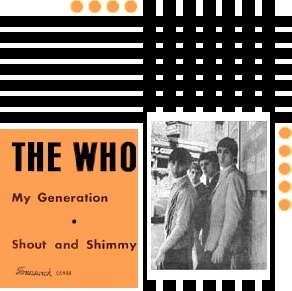 There is only speculation of the term rock 'n' roll, though one sexually explicit ditty comes to mind, Trixie Smith's 1922 "My Man Rocks Me (With One Steady Roll)". Others may suggest the household standard "Rock-a-bye Baby" from 1809 as the term's catalyst, but that's just dumb. Rock, if not sexually motivated, is at a minimum motivated in passion, and it was in 1965 that that that passion became a lifestyle, a movement, a reason to leave home and converge on Frisco bay, to smoke dope and protest the war, to "turn on, drop out and tune in." That phrase wasn't popularized by Leary until '66, but it's this writer's opinion that it was the music, "rock" to be specific, that inspired the events of the Summer of Love and Woodstock and not exclusively the other way around. The Beatles (The Stones, as well and so many more), were a product and a catalyst of their time.
There is only speculation of the term rock 'n' roll, though one sexually explicit ditty comes to mind, Trixie Smith's 1922 "My Man Rocks Me (With One Steady Roll)". Others may suggest the household standard "Rock-a-bye Baby" from 1809 as the term's catalyst, but that's just dumb. Rock, if not sexually motivated, is at a minimum motivated in passion, and it was in 1965 that that that passion became a lifestyle, a movement, a reason to leave home and converge on Frisco bay, to smoke dope and protest the war, to "turn on, drop out and tune in." That phrase wasn't popularized by Leary until '66, but it's this writer's opinion that it was the music, "rock" to be specific, that inspired the events of the Summer of Love and Woodstock and not exclusively the other way around. The Beatles (The Stones, as well and so many more), were a product and a catalyst of their time.It was 50 years ago that rock took on a new significance, one that had been the job of folk and then Dylan went electric to a cacophony of ballyhoo - but for a moment - and then no one cared anymore. We can argue all we want over rock's greatest year, '67? '72?, IDK, everything from Revolver to My Aim is True, but you can't argue that it was '65 when rock got real.
Published on December 20, 2018 04:50
December 19, 2018
The 27s
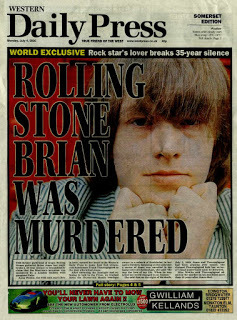 Brian Jones was one of the 27 Club, that ominous list of rock musicians who died at the wrong moment. Indeed, so many hugely successful and talented musicians have died at age 27 that it almost seems reasonable to believe the number represents some mystical coefficient of talent and tragedy. Most famous of the group is the trilogy of deaths in the early 70s, Janis, Jimi and Jim Morrison, who died exactly two years from the death of Brian Jones. Jones, though, wasn't the first; that distinction goes to Robert Johnson.
Brian Jones was one of the 27 Club, that ominous list of rock musicians who died at the wrong moment. Indeed, so many hugely successful and talented musicians have died at age 27 that it almost seems reasonable to believe the number represents some mystical coefficient of talent and tragedy. Most famous of the group is the trilogy of deaths in the early 70s, Janis, Jimi and Jim Morrison, who died exactly two years from the death of Brian Jones. Jones, though, wasn't the first; that distinction goes to Robert Johnson.Johnson, as you recall, sold his soul to the devil at the Crossroads in Rosedale, Mississippi so he could attain his virtuosity with the guitar. After several gigs as a young guitarist, Johnson, disgusted with his inabilities and the audience abuse, consistently being booed off the state, disappeared, only to return to the Delta the most influential guitarist of all time (just ask Keith or Eric). Johnson recorded 29 songs - many of them classics - during a short, storied career, including “Come on in My Kitchen,” “Sweet Home Chicago” and, of course, “Crossroad Blues,” famously covered by the rock group Cream on their double album set Wheels of Fire. It is generally accepted that Johnson was poisoned – perhaps given some tainted rye moonshine - by a jealous husband or girlfriend while playing at a juke joint near Greenwood, Mississippi. Johnson took days to die and was buried in an unmarked grave. He passed on August 16, 1938.
 We don't often acknowledge “Blind Owl” Wilson, one of the seminal members of Canned Heat, a Sixties blues-revival band. Wilson was a rhythm guitarist, songwriter, vocalist and virtuoso harmonica player. Blues legend John Lee Hooker called Wilson the best harmonica player he had ever seen. Wilson sang the lead on two of Canned Heat's greatest hits, well, their only hits, "Going Up the Country" and "On the Road Again." Wilson had emotional problems and attempted suicide numerous times. He died of a drug overdose - widely considered a suicide - on September 3, 1970.
We don't often acknowledge “Blind Owl” Wilson, one of the seminal members of Canned Heat, a Sixties blues-revival band. Wilson was a rhythm guitarist, songwriter, vocalist and virtuoso harmonica player. Blues legend John Lee Hooker called Wilson the best harmonica player he had ever seen. Wilson sang the lead on two of Canned Heat's greatest hits, well, their only hits, "Going Up the Country" and "On the Road Again." Wilson had emotional problems and attempted suicide numerous times. He died of a drug overdose - widely considered a suicide - on September 3, 1970.Pigpen McKernan, keyboardist, singer and harmonica player,was one of the founding members of the Grateful Dead. McKernan was known for his thick, weathered vocals on such tunes as “Midnight Hour” and “Death Don’t Have No Mercy.” McKernan once had a fling with fellow boozer Janis Joplin and sang with her at some gigs. (According to singer Grace Slick of the Jefferson Airplane, McKernan introduced Joplin to Southern Comfort.) When McKernan's health began deteriorating, he left the Grateful Dead in 1972. On March 8, 1973 Pigpen was found dead of a stomach hemorrhage brought on by years of heavy drinking.
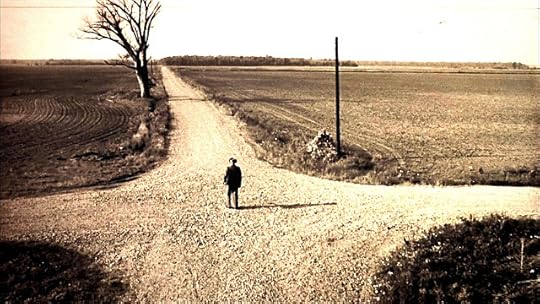 I don't really recall any of the deaths as listed, but will never forget that day when Kurt Cobain died. Led by Cobain's songwriting, singing and lead guitar, Nirvana’s second album Nevermind hit the top of the charts in 199, but Cobain, a quiet, recluse, never enjoyed the limelight of celebrity. Nirvana’s mega hit single, "Smells Like Teen Spirit," is considered one of the greatest rock tunes of all time. As Nirvana gained popularity, Cobain started using heroin in the early 1990s. He may have started taking heroin to relieve pain from chronic back and stomach trouble. Cobain said his stomach pain was so bad at times that he sometimes considered committing suicide. In March of 1994 Cobain attempted suicide by gobbling painkillers washed down with champagne. But on April 5, 1994 Kurt Cobain succeeded in ending his life with a shotgun blast to the head.
I don't really recall any of the deaths as listed, but will never forget that day when Kurt Cobain died. Led by Cobain's songwriting, singing and lead guitar, Nirvana’s second album Nevermind hit the top of the charts in 199, but Cobain, a quiet, recluse, never enjoyed the limelight of celebrity. Nirvana’s mega hit single, "Smells Like Teen Spirit," is considered one of the greatest rock tunes of all time. As Nirvana gained popularity, Cobain started using heroin in the early 1990s. He may have started taking heroin to relieve pain from chronic back and stomach trouble. Cobain said his stomach pain was so bad at times that he sometimes considered committing suicide. In March of 1994 Cobain attempted suicide by gobbling painkillers washed down with champagne. But on April 5, 1994 Kurt Cobain succeeded in ending his life with a shotgun blast to the head. 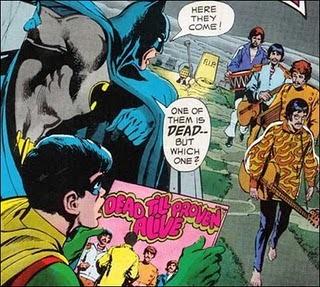 There are 20+ others who meet the somber criteria (Amy Winehouse, the most recent), one among them, of course, the biggest hoax in rock history, the death of Paul, most famously addressed by the VW license plate on the cover of Abbey Road that says, "28 IF" (28 if he had lived). The Paul is dead theory remains an excellent example of how a group of dedicated conspirists can gather surprisingly compelling evidence for a theory — even if that theory is utterly ridiculous. There is so much from which to glean information, but let's stick to the two most famous visual sources and leave it up to you to find the backmasking and the rest if you're so inclined.
There are 20+ others who meet the somber criteria (Amy Winehouse, the most recent), one among them, of course, the biggest hoax in rock history, the death of Paul, most famously addressed by the VW license plate on the cover of Abbey Road that says, "28 IF" (28 if he had lived). The Paul is dead theory remains an excellent example of how a group of dedicated conspirists can gather surprisingly compelling evidence for a theory — even if that theory is utterly ridiculous. There is so much from which to glean information, but let's stick to the two most famous visual sources and leave it up to you to find the backmasking and the rest if you're so inclined.Sgt. Pepper is, of course, a famously busy album cover, a rich source of conspiracy leads. There's an open palm over McCartney’s head, which fans interpreted as being akin to a priest blessing the dead. In the corner, next to a doll wearing a "Welcome the Rolling Stones romper, is a driving glove symbolizing McCartney’s bloody death. A bass guitar made of flowers in the foreground only has three strings, symbolizing a dead McCartney as the missing string. The Beatles wanted a psychedelic way to communicate to fans that their mop-topped collarless suit days were over, and no conspiracy is complete with the dower look of the Madame Tassauds' wax sculptures peering over Paul's grave.
Although it has since become a rock icon, the cover for Abbey Road remains a triumph of lazy album artwork. The Beatles simply walked out of the studio in whatever they were wearing and posed on an adjacent crosswalk (here's the live came feed). McCartney, notably, didn't even bother to put on shoes. But fans interpreted the four as representing a funeral procession: A gravedigger (Harrison), a corpse (Paul), an undertaker (John) and a priest (Ringo). According to theorists, McCartney’s shoelessness was a nod to the practice of interring corpses without shoes, which of course in itself is a myth.
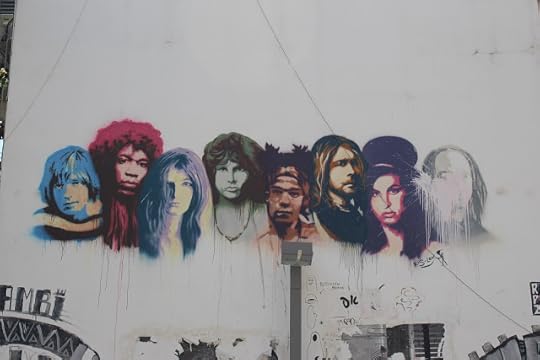 Cool Tel-Aviv Graffiti
Cool Tel-Aviv Graffiti
Published on December 19, 2018 17:42
December 18, 2018
The Total Eclipse of Brian Jones
 Brian Jones, alongside Richards and Jagger, formed The Stones in 1962, with Jones the key player, the catalyst behind the name and their blues edge. That distinction would carry on through the cover years (1962 to 1965), when finally Jagger and Richards would put pen to paper and determine not merely to write LP filler. The band was known early on for highlighting songs by Lennon/McCartney, Sonny Bono, Jerry Lieber or Chuck Berry, a concept not dissimilar to Vanilla Fudge. Though a satisfying venture into blues, The Stones through Out of Our Heads were essentially a tribute band ("Satisfaction," the quintessential Stones track, was only released on LP in the U.S.). Even the follow up LP, December's Children, featured only five (of 12) songs by the fledgling composers. The Stones wouldn't really come into their own until Aftermath in 1966. From there, they took on the Beatles rivalry that had always been the job of The Beach Boys.
Brian Jones, alongside Richards and Jagger, formed The Stones in 1962, with Jones the key player, the catalyst behind the name and their blues edge. That distinction would carry on through the cover years (1962 to 1965), when finally Jagger and Richards would put pen to paper and determine not merely to write LP filler. The band was known early on for highlighting songs by Lennon/McCartney, Sonny Bono, Jerry Lieber or Chuck Berry, a concept not dissimilar to Vanilla Fudge. Though a satisfying venture into blues, The Stones through Out of Our Heads were essentially a tribute band ("Satisfaction," the quintessential Stones track, was only released on LP in the U.S.). Even the follow up LP, December's Children, featured only five (of 12) songs by the fledgling composers. The Stones wouldn't really come into their own until Aftermath in 1966. From there, they took on the Beatles rivalry that had always been the job of The Beach Boys.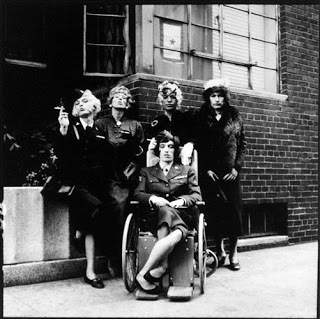
The Stones rise to power was in direct correlation to the eclipse of Brian Jones. Jones had always been the spiritual leader of the band, despite Jagger's vocals and Richards' role as lead guitar. Jones on Rolling Stones Now!, for instance, is credited with guitar and slide guitars, harmonica and backing vocals, while being instrumental in The Stones covering the likes of Willie Dixon. On Out of Our Heads, the lessened role is nearly imperceptible, but there nonetheless, with Jones credited to guitar on seven tracks, acoustic guitar and harmonica on one. For the next three LPs, Aftermath, Between the Buttons and Her Satantic Majesties, the role as vocalist and guitarist was diminished, with the addition of odd instruments (wisely added to the band's bluesy sound) like the dulcimer, marimba, banjo, even the kazoo. Jones indeed was part George Harrison, part Syd Barrett.
Inspired by George Harrison's Indian excursions, Jones would later don the role of Eastern spiritual adviser, at least when it came to instrumentation, but not until Beggar's Banquet. By Let it Bleed, though, Jones' eclipse (call this the path of totality), was readily apparent, with the band founder playing only the congas on "Midnight Rambler" and the autoharp on "You Got Silver." The LP, of course would be The Stones last of the 60s, and the last LP with Jones' input. While Harrison was coming into his own, and Barrett was wallowing in psychedelics, Brian Jones had found a darker, back way out.
Published on December 18, 2018 18:13
December 11, 2018
Pops' Big Comeback - 1968
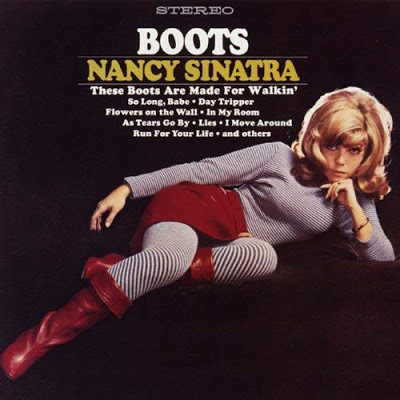 1968 was the year that rock grew up. It was the first year that album sales outdid 45s, the year of the double disk and the mellotron. While 1967 had more in the way of content, 1968 was the year that artists hit the studio like never before. Psychedelia was still a key element with In-A-Gadda-Da-Vida gaining the first RIAA platinum status (1 million sold). Soul music, reeling from the loss of Otis Redding, still had Stax and Motown, with the latest black music offshoot, psychedelic soul, about to go stratospheric.
1968 was the year that rock grew up. It was the first year that album sales outdid 45s, the year of the double disk and the mellotron. While 1967 had more in the way of content, 1968 was the year that artists hit the studio like never before. Psychedelia was still a key element with In-A-Gadda-Da-Vida gaining the first RIAA platinum status (1 million sold). Soul music, reeling from the loss of Otis Redding, still had Stax and Motown, with the latest black music offshoot, psychedelic soul, about to go stratospheric. In the real world, the idealistic peace/love vibe of 1967 had given way to the grim reality of global unrest as Russian tanks rolled into Prague and the war in Vietnam escalated. Martin Luther King Jr and Robert Kennedy were assassinated and there were riots and uprisings in major cities around the world. 1968 was a pivotal year for social and world-changing events, and as befitting the new mature status of the medium, much of the turmoil and upheaval was reflected in the music.
Despite this, 1968 also saw a myriad of pop, jazz and instrumental songs on AM radio. Something that rarely happens today. It wasn't a new phenomenon, Astrud Gilberto had sold over 1 million copies of "The Girl From Ipanema" way back in 1964, but by 1968, jazz pop songs were all over the radio dial.
From a jazz perspective, there was Sergio Mendes and Brazil '66 who had a runaway hit with the Portuguese language "Mas Que Nada" and "Going Out of My Head." A string of hits continued for the next several years and in 1968, two songs made it into the pop charts: "Scarborough Fair," a cover of the Simon & Garfunkel tune and The Beatles' "Fool on the Hill," both with the incomparable vocals of Lani Hall. The LP was produced by Herb Alpert and Jerry Moss, the A and the M from A&M Records.
Herb Alpert would have a hit with the 1965 pop trumpet version of "A Taste of Honey" and then go on to hit No. 1 in 1968 with "This Guy's in Love With You." Alpert and Moss had an incredible collection of artists under contract from Burt Bacharach to Cat Stevens, The Carpenters, Quincy Jones, Supertramp; an endless list that by the mid-70s made A&M the largest independent record label in the world.
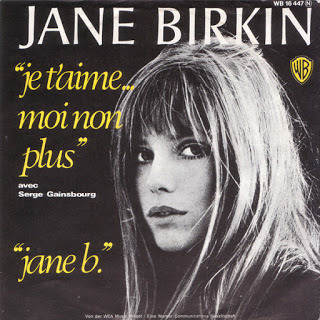 Paul Mauriat's "Love is Blue" was the 2nd biggest selling song of 1968 behind "Hey Jude." The track hit No. 1 in January and would stay there for five weeks. A Francophile fascination that started with the iconic instrumental "A Man and a Woman" and included Andy Williams' wife Claudine Longet (look her up for an interesting story) would continue into 1968 with the recording of "Je t'aime…Moi Non Plu" by Serge Gainsbourg and Jane Birkin. The song would be banned in many countries for its sexually explicit content. The title roughly translates to "I love you…Neither Do I" causing a ban in France for its explicit sexual nature without love, because of which the song was deemed pornographic.
Paul Mauriat's "Love is Blue" was the 2nd biggest selling song of 1968 behind "Hey Jude." The track hit No. 1 in January and would stay there for five weeks. A Francophile fascination that started with the iconic instrumental "A Man and a Woman" and included Andy Williams' wife Claudine Longet (look her up for an interesting story) would continue into 1968 with the recording of "Je t'aime…Moi Non Plu" by Serge Gainsbourg and Jane Birkin. The song would be banned in many countries for its sexually explicit content. The title roughly translates to "I love you…Neither Do I" causing a ban in France for its explicit sexual nature without love, because of which the song was deemed pornographic.It's an interesting phenomenon that while music was progressively moving toward harder-edged rock, away from rock 'n' roll, and disassociating itself from the soft pop content of artists like Bobby Vinton and Johnny Mathis, here we were in 1968 with these incredible pop hits staking their claim among the most popular of the year, as if taking one long last breath that put artists like Frank Sinatra back into the limelight. Frank's reclaiming the top spots began in 1966 with the year's biggest single, "Strangers in the Night." In 1967, Frank's comeback would include a duet with daughter Nancy called "Something Stupid." Nancy, of course, had hit it big with "These Boots Were Made for Walkin'." One of Frank's all-time biggest hits would come in 1968, 50 years ago, with "My Way."
Like pop and Frank making a comeback, 2018 has seen vinyl sell more copies than any year since 1989. There is indeed nothing new under the sun.
Published on December 11, 2018 03:52
December 10, 2018
Have a Beatles Christmas!
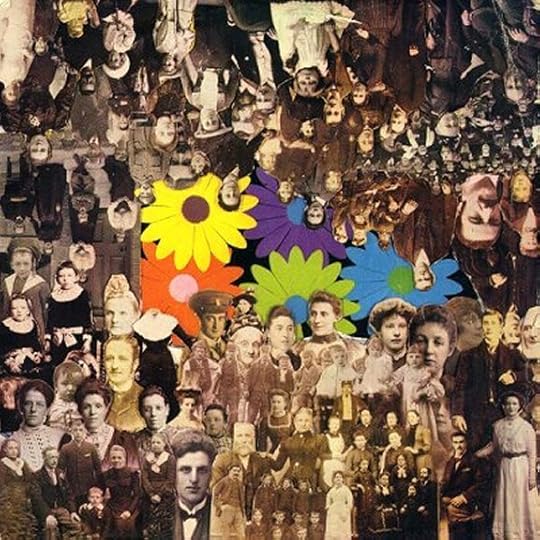 Between 1962 and 1970, the Beatles recorded one musical masterwork after another, with 27 No. 1 hits in the United States and the United Kingdom, and 11 British LPs (plus the Magical Mystery Tour EP – 11 American Capitol releases). Yet for today's listener, the Fab Four's annual Christmas offerings are all but forgotten. The band's Christmas records were originally conceived as a means for providing holiday greetings to their legions of loyal fans through the Beatles' Fan Club. Beginning in December 1963, British fan club members received annual Christmas messages as free "flexi-disc" record releases. For the inaugural release, the Beatles sang the Christmas carol "Good King Wenceslas" and the comic "Rudolph the Red-Nosed Ringo." American releases, for whatever reason, were usually released in January of the following year. While their British counterparts were given “flexi-disc” records, American fans received cardboard record releases in the mail. Over the years, The Beatles released such titles as “Did You Wash Your Father’s Shirt?” and a bevy of holiday faves.
Between 1962 and 1970, the Beatles recorded one musical masterwork after another, with 27 No. 1 hits in the United States and the United Kingdom, and 11 British LPs (plus the Magical Mystery Tour EP – 11 American Capitol releases). Yet for today's listener, the Fab Four's annual Christmas offerings are all but forgotten. The band's Christmas records were originally conceived as a means for providing holiday greetings to their legions of loyal fans through the Beatles' Fan Club. Beginning in December 1963, British fan club members received annual Christmas messages as free "flexi-disc" record releases. For the inaugural release, the Beatles sang the Christmas carol "Good King Wenceslas" and the comic "Rudolph the Red-Nosed Ringo." American releases, for whatever reason, were usually released in January of the following year. While their British counterparts were given “flexi-disc” records, American fans received cardboard record releases in the mail. Over the years, The Beatles released such titles as “Did You Wash Your Father’s Shirt?” and a bevy of holiday faves.  For Fan Clubbers and Beatlemaniacs, the band's 1967 Christmas record exists as a watershed moment in the Fab Four's brief history of holiday messages. For the recording, the Beatles concocted a six-minute narrative in which various groups audition for a BBC radio show, with the catchy "Christmas Time (Is Here Again)" serving as the track's periodic refrain. During the comic narrative, the four Beatles’ voice various characters ranging from game-show contestants and musicians (the Ravellers) to actors in a fictive radio program titled "Theatre Hour." For the Beatles, "Christmas Time (Is Here Again)" would emerge as their most recognizable holiday tune.
For Fan Clubbers and Beatlemaniacs, the band's 1967 Christmas record exists as a watershed moment in the Fab Four's brief history of holiday messages. For the recording, the Beatles concocted a six-minute narrative in which various groups audition for a BBC radio show, with the catchy "Christmas Time (Is Here Again)" serving as the track's periodic refrain. During the comic narrative, the four Beatles’ voice various characters ranging from game-show contestants and musicians (the Ravellers) to actors in a fictive radio program titled "Theatre Hour." For the Beatles, "Christmas Time (Is Here Again)" would emerge as their most recognizable holiday tune.
Published on December 10, 2018 04:18
December 8, 2018
But Baby, It's Cold Outside
More than 50 years ago, Jim Morrison took a firm stance as a dissident poet when The Doors appeared on The Ed Sullivan Show to perform "Light My Fire." The lyrics, of course, include the phrase, "Girl we couldn’t get much higher" and Morrison was told he couldn't sing the word "higher" on air. It was agreed that Jim would replace "higher" with "better," despite the song being the No. 1 hit worldwide. Of course, Morrison sang the original lyrics as intended and when all was sung and done, Sullivan proclaimed, "You will never do this show again." Jim, being Jim, turned to Sullivan and replied, "Hey, that's okay – we just did the Ed Sullivan show."
Mick Jagger, despite The Stones having the reputation as the bad boys of rock, were faced with the same censorship when Sullivan demanded that the band change "Let's Spend the Night Together" to "Let's Spend Some Time Together." The Stones, though, would bow down to Sullivan's demands. That same year, the BBC banned The Beatles "Lucy in the Sky with Diamonds" for its inherent reference to LSD, pointing out that the acronym was even in the song's title with the words Lucy, Sky and Diamonds. Van Morrison's "Browned-Eyed Girl" was originally titled "Brown-Skinned Girl" but Van altered it for a more "radio friendly" title before it was released. Interestingly in the 50s, artists like Little Richard and Chuck Berry, whose sexual inuendo was far more obvious, flew right under the radar.
Censorship on radio was clearly a reaction in the 60s to changing times and mores, and 50 years later, we're still at it. While AM rarely takes a political stance, I have to come out in support of "Baby, It"s Cold Outside," a Holiday tune written by Frank Loesser in 1944. Are we really moving toward a world in which flirtation and the sensual inuendo that has been the catalyst for dating since The Flintstones is banned?
Seriously, "Baby, It's Cold Outside" is considered "rapey," based on the line: "Say, what's in this drink," which many naive listeners assume is a reference to a date rape drug, ignoring what precedes and follows the line. The song's structure is conversational repartee between the male and female singers. Every statement the woman makes is answered in turn, until the two come together at the end of the song.
Our romantic tale is of a woman who has dropped by her beau's house on a cold winter night. They talk about how long she's going to stay. She has "another drink" and stays a little longer, and later it's implied that she will stay the night. Keep in mind the woman provides plenty of evidence that she does indeed want to stay in a time when "good" girls did no such thing. The tension is brought about based on her desires. Her beau's response offers the justification she needs to stay without guilt, never once proclaiming that she doesn't want to. Her beau has a myriad of reasons for her stay that include it's snowing, the cabs aren't running, the storm is getting worse, and she might get hurt trying to get home.
Interestingly, another politicized criticism is the man's flirtatious "trolling" by stating that she has beautiful eyes, that her lips look "delicious," and her hair looks "swell."
The song ends with the couple, now in harmony deciding that she will indeed stay. Preposterous! Bottom line, boys and girls, it's a Christmas song; not everything needs to be politicized.
Published on December 08, 2018 17:13
December 6, 2018
na
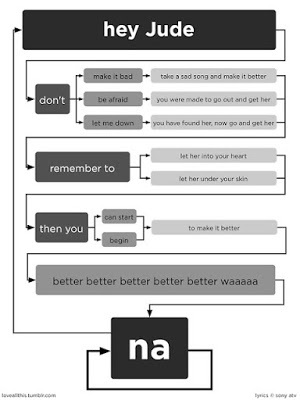 Four and a half years after they first appeared on The Ed Sullivan Show and charmed teenie-boomers with their yeah yeah yeahs, The Beatles released "Hey Jude," a revolutionary and mature track far removed from the mop tops early work, even if it utters the word "na" 240 times.By 1968 the Fab Four's Edwardian suits were long gone, as was the notion that they were simply the flavor-of-the-month. The Beatles ditched live concerts to experiment in the studio, and while they didn't have a stranglehold on the Billboard charts as they did in 1964 (when at one point they had the top five hits), their music remained wildly popular."Hey Jude," like "She Loves You," is the story of a friend offering advice, but the world, as well as the music, had grown more complex. Paul McCartney has said he wrote it to cheer up Julian Lennon, John's five-year-old son, when Lennon was divorcing his first wife. The narrator realizes that things may not be good now, but with a little work he can find his true love "and make it better."
Four and a half years after they first appeared on The Ed Sullivan Show and charmed teenie-boomers with their yeah yeah yeahs, The Beatles released "Hey Jude," a revolutionary and mature track far removed from the mop tops early work, even if it utters the word "na" 240 times.By 1968 the Fab Four's Edwardian suits were long gone, as was the notion that they were simply the flavor-of-the-month. The Beatles ditched live concerts to experiment in the studio, and while they didn't have a stranglehold on the Billboard charts as they did in 1964 (when at one point they had the top five hits), their music remained wildly popular."Hey Jude," like "She Loves You," is the story of a friend offering advice, but the world, as well as the music, had grown more complex. Paul McCartney has said he wrote it to cheer up Julian Lennon, John's five-year-old son, when Lennon was divorcing his first wife. The narrator realizes that things may not be good now, but with a little work he can find his true love "and make it better."
Published on December 06, 2018 05:42



